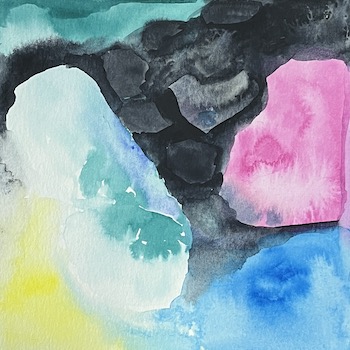Watercolor Fun

There are so many different art materials to choose from and you’ll never know what you like until you try them! You might think you’re not creative, but you are - all humans are creative - and sometimes we just need to discover the medium that resonates with us the most.
Today, I encourage you to experiment with watercolor paints. I want you to have fun and play with the paints - don’t try to plan something, don’t expect to complete a masterpiece. Let yourself enjoy the process of experimenting with the watercolors to see what happens. Artists are always trying new things in their studios and experimenting with new techniques. The finished artwork you see displayed in galleries is often a culmination of the work that is done in the studio, which may contain dozens of paintings that did not make it to the gallery but are no less an important part of the process.
Materials
You will need a set of watercolor paints (most will come with a brush) and a few sheets of watercolor paper. These can be found in any arts and crafts store. The brand or quality of the materials are not very important at this stage. If you find that you absolutely love painting with watercolors, then you will want to try different brands and qualities of paints. You will also need a jar of water to rinse your brush between colors and paper towel for clean up.
Techniques
Remember that this is a time to play and experiment! Before you start painting you will need to get your paints wet - simply drop a bit of water onto each of the colors to get them ready.
This list of techniques contains only a few to get you started:
- Wet on wet: dip your brush in water and wet a section of the paper, then dip your brush in a color and put that onto the wet section of the paper. Watch what happens… the watercolor paint should move into the water on the paper and spread out, sometimes looking similar to fireworks. You could use this technique to paint a wash of color over your paper as a base to add more paint or drawing on top of after it dries.
- Wet on dry: this is similar to the technique above, but your paper stays dry. Notice how the paint behaves differently. You can vary the look of the watercolor by lifting some of the paint with a paper towel.
- Color blending: try adding a new color next to a color that is still wet on your paper - allowing them to touch and blend creating a beautiful abstract image.
Remember to have fun with your watercolor painting. There is no need to judge or criticize your work, this is an exercise in playful, creative experimentation! Share your work with us on the C.A.R.E. Program Facebook page.
Connect with us:
The C.A.R.E. Program team would love to connect with you!
- Register for one of our Caregivers classes
- Join the conversation in our Facebook group
References:
.svg?iar=0&hash=F6049510E33E4E6D8196C26CCC0A64A4)

/hfh-logo-main--white.svg?iar=0&hash=ED491CBFADFB7670FAE94559C98D7798)